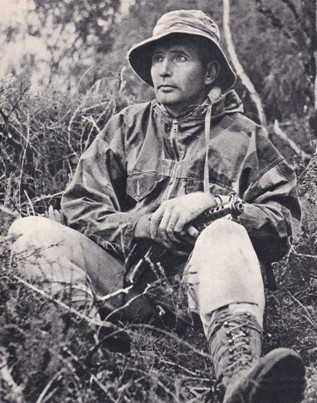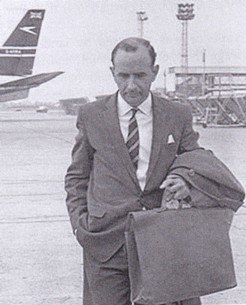View entry
Name: HENDERSON, Ian Stuart McWalter GM* (Major General)


Photo Source: SitrepXLII
Nee: son of John Laidlaw Henderson
Birth Date: 8 Mar 1927 Nairobi
Death Date: 13 Apr 2013 Bahrain
First Date: 1928
Last Date: 1964
Profession: Kenya Police; retired as Assistant Commissioner. Director of Intelligence Bahrain.
Area: Nairobi, Kiambu, Nyeri
Married: In St. Andrew's Church, Nairobi 1949 Marie Beatrice Green b. 2.10.1928 Nairobi (dau. of Cecil John Percival Green)
Children: Lynda Carol (25.9.1951); Gavin Ian Laidlaw (1959)
Author: The Hunt for Kimathi
Book Reference: Gillett, EAWL, Best, Sundown, Legion, EA & Rhodesia, Foster
War Service: Mau Mau insurgency
School: Prince of Wales School
General Information:
Best - detailed description of his hunt for Kimathi in Mau Mau Emergency.
Legion - This entry does not indicate that Ian Henderson was awarded the George Medal and the Bar to it for his Police work in Kenya. He is one of only two people ever to have won the GM twice.
EA & Rhodesia - 7 October 1954 - The Queen has approved the following immediate awards to 4 officers and 3 inspectors of the Special Branch of the Kenya Police Force for conspicuous gallantry and outstanding service in the negotiations with the Mau Mau terrorists in the Mount Kenya area between February and April this year - The George Medal - Superintendent Ian Stewart MacWalter Henderson; aged 27
Legion - Flying Squad Division, Kenya Police,
Sitrep XLII Towards the end of his life he had to fight allegations he had participated in torture in Bahrain, when he was head of security there. He had been expelled from Kenya in 1963. Ian Stuart McWalter Henderson was born in Aberdeenshire in 1927 but grew up in Kenya, where his father, Jock, had been sent by a firm of Scottish seed merchants before the First World War. Jock Henderson stayed on and became a farmer near the Kikuyu township of Nyeri, near the Aberdare Mountains. As there were no white playmates nearby, Ian grew up among the Kikuyu, becoming fluent in their language and learning the skills of tracking and bushcraft. At Prince of Wales School, Nairobi, he was good at sport and became a lance-corporal in the school cadet corps. After leaving school in 1945 he joined the Kenyan police. Henderson's knowledge of the Kikuyu, unusual among British colonialists, stood him in good stead, and he was soon moved from bicycle thefts and traffic duties to armed robbery and murder cases. In the early 1950s, he was transferred to Special Branch, where one of his first duties was commanding the royal guard at Sagana Lodge when the young Princess Elizabeth visited in 1952.
The Mau Mau uprising began later that year. In January 1954, when Waruhiu Itote, a Mau Mau leader better known under his pseudonym 'General China', fell into the government's hands, Henderson was the chief interrogator. Itote was found guilty and sentenced to hang. However, following a deal negotiated by Henderson (some reports allege that torture was involved, though Henderson denied it), Itote agreed to cooperate with the government and negotiate an end to the uprising in return for his life. Subsequently Henderson was put in charge of a Special Branch detachment assigned to visit other Mau Mau leaders at their bases in the Kenyan forests, to persuade them to give up terrorism and enter talks with the government. This involved repeated unarmed trips into the forest to negotiate surrender terms with heavily-armed and highly neryous Mau Mau gangs. The talks were abortive, but they won Henderson his two George Medals, in 1954 and 1955, the citation to the first noting: 'The nature of this assignment made it necessary for Mr. Henderson to travel frequently into the forests and parts of the reserves occupied by terrorists under conditions of extreme vulnerability in order to achieve the objective.' But it was Henderson, above all, who masterminded one of the most effective elements of the strategy that eventually crushed the uprising. This was the use of so-called 'pseudo-gangs', fake guerrilla bands, mostly composed of former Mau Mau, sent into the forests to gather intelligence, infiltrate the movement and track down its leaders. Henderson said 'the methods of conversion were many, but the key to
their success was kind and gentle handling', though he also gained much intelligence by talking to Mau Mau fighters held at the now notorious detention camps. By the beginning of 1956, the Mau Mau movement had been seriously circumscribed, and the security situation had improved so radically that a major action was launched to eliminate the elusive Dedan Kimathi, the last important Mau Mau leader still at large. On October 2I 1956, Henderson and his men scored their greatest triumph when, betrayed by his own followers, Kimathi was tracked down to his forest hideout. In his account of the campaign, 'Hunt for Kimathi' (1958, also published under the title 'Man Hunt in Kenya'), Henderson recalled that wild animals had been as much of a problem to the trackers as the terrorists themselves, and implied that the only effect of much-vaunted-RAF bombings of the forest was to make the animals even more dangerous than usual. On the day Kimathi was captured, Henderson had to leave the jungle hunt to be presented to Princess Margaret at a teaparty at Government House in Nairobi, an incongruous interlude from which he was called away to interrogate the captured Mau Mau leader at Nyeri.
their success was kind and gentle handling', though he also gained much intelligence by talking to Mau Mau fighters held at the now notorious detention camps. By the beginning of 1956, the Mau Mau movement had been seriously circumscribed, and the security situation had improved so radically that a major action was launched to eliminate the elusive Dedan Kimathi, the last important Mau Mau leader still at large. On October 2I 1956, Henderson and his men scored their greatest triumph when, betrayed by his own followers, Kimathi was tracked down to his forest hideout. In his account of the campaign, 'Hunt for Kimathi' (1958, also published under the title 'Man Hunt in Kenya'), Henderson recalled that wild animals had been as much of a problem to the trackers as the terrorists themselves, and implied that the only effect of much-vaunted-RAF bombings of the forest was to make the animals even more dangerous than usual. On the day Kimathi was captured, Henderson had to leave the jungle hunt to be presented to Princess Margaret at a teaparty at Government House in Nairobi, an incongruous interlude from which he was called away to interrogate the captured Mau Mau leader at Nyeri.
